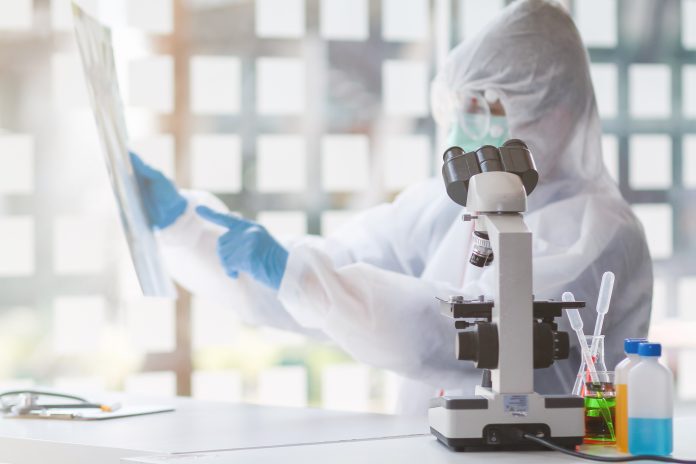Prashant Dogra1, Kavya Sinha2, Zhihui Wang1, Vittorio Cristini1,*
1Mathematics in Medicine Program, Houston Methodist Research Institute, Houston, Texas
2Department of Cardiovascular Surgery, Houston Methodist DeBakey Heart & Vascular Center, Houston, Texas
*Correspondence: vcristini@houstonmethodist.org
Severe acute respiratory syndrome coronavirus 2 (SARS-CoV-2) is a pathogen of immense public health concern, having caused ~4.1 million confirmed cases of coronavirus disease 2019 (COVID-19) and ~283,000 deaths worldwide (as of May 11th, 2020). As a result, COVID-19 has been designated as a Public Health Emergency of International Concern by the World Health Organization (WHO). SARS-CoV-2 has a single-stranded positive-sense RNA genome of about 30,000 nucleotides in length and encodes ~27 proteins and four structural proteins. The spike protein mediates receptor binding and membrane fusion, and the virus interacts with the angiotensin-converting enzyme 2 (ACE2) receptor for entry into cells [1]. ACE2 mRNA has a presence in almost all organs of the human body and is especially expressed on the surface of lung alveolar epithelial cells and enterocytes of the small intestine, thereby allowing a preferential accumulation of the virus in these organs [2]. The incubation period of COVID-19 ranges from about 3-17 days and the diagnosis of COVID-19 cannot be made by symptoms alone as most are nonspecific and may be confused for more common ailments such as the flu. Screening of COVID-19 is being done by nucleic acid testing through RT-PCR (specimens from both upper and lower respiratory tracts) and pulmonary CT scans. The viral load in naso- or oro-pharyngeal swabs is the key clinical biomarker of COVID-19 and also the key clinical endpoint of pharmacological intervention.
As evident from the recent outbreak of COVID-19, viral infections can be a global public health concern. The origin of the outbreak was centered in Wuhan, China and while a strict quarantine was implemented, the virus spread throughout China, Asia, Europe, Africa, and North America quickly [3]. An outbreak at the scale of a pandemic is a tremendous socio-economic burden due to thwarted productivity, a spike in healthcare expenses, and immense loss of human lives [4]. The enormity of such outbreaks and their impact on the human race highlights the necessity for an immediate and in-depth evaluation of viral-host interactions, in order to readily understand the mechanisms of disease pathogenesis for the development of pharmacological treatments and efficient disease management.
The application of mathematical modeling and quantitative methods has been instrumental in our understanding of viral-host interactions of various viruses, including influenza, HIV, HBV, and HCV in the past [5]. These kinetic models have been developed for various spatial scales including, molecular, cellular, multicellular, organ, and organism. By analyzing viral load kinetics, these models have deepened our understanding of the fundamentals of viral-host interaction dynamics, innate and acquired immunity, drug effects, and drug resistance.
While the fundamental principles governing different viral infections remain the same, the kinetics of the underlying mechanisms may vary based on the virus-type. In the context of SARS-CoV-2, mathematical modeling has been a powerful tool in understanding the outbreak of COVID-19 and thus guiding the efforts of governments worldwide in containing the spread of infection. While most of the models developed so far have focused on the epidemiological aspect of COVID-19 to understand the inter-human transmission dynamics of SARS-CoV-2, there are only a limited number of studies that investigate viral-host interactions and pathogenesis of COVID-19.
In this direction, Goyal et al. developed a mathematical model to predict the therapeutic outcomes of various COVID-19 treatment strategies [6]. Their model is based on a target cell-limited viral dynamics model [7] and incorporates the immune response to infection to predict viral load dynamics in patients pre- and post-treatment with various antiviral drugs. They use their model to project viral dynamics under hypothetical clinical scenarios involving drugs with varying potencies, different treatment timings post-infection, and drug resistance. The simulation results suggest the application of potent antiviral drugs prior to the peak viral load stage, i.e. pre-symptomatic stage, as an effective means of controlling infection in the body. Their model is validated clinically using nasopharyngeal viral load kinetics data only, and thus does not provide the viral dynamics of other important compartments of the body, especially lungs and blood. Similarly, Gonçalves et al. used a target cell limited model to model the viral dynamics of patients and estimate viral growth parameters and predict the efficacy of antiviral therapy [8]. Vargas et al. used a similar target cell limited model, with an immune response to infection component, to model viral dynamics and understand the mechanism of infection [9]. Further, Wang et al. developed a prototype multiscale model to simulate SARS-CoV-2 dynamics at the tissue scale [10]. They used an agent-based modeling approach to simulate intracellular viral replication and spread of infection to neighboring cells. The model has not been validated yet, therefore caution should be executed in its application to test clinical hypotheses.
In order to improve upon the existing models, we recommend that a multiscale mechanistic model that captures the viral-host interactions locally, and is also capable of simulating the whole-body dynamics of SARS-CoV-2 infection, is necessary to gain insights into disease pathogenesis and pathophysiology and to explain the typical and atypical presentations of COVID-19. Importantly, using such an in silico platform, we can conduct virtual clinical trials to identify treatment strategies for effective suppression of viral load based on patient attributes and underlying conditions.
References
[1] D. Wrapp et al., “Cryo-EM structure of the 2019-nCoV spike in the prefusion conformation,” Science, vol. 367, no. 6483, pp. 1260-1263, 2020.
[2] I. Hamming, W. Timens, M. Bulthuis, A. Lely, G. Navis, and H. van Goor, “Tissue distribution of ACE2 protein, the functional receptor for SARS coronavirus. A first step in understanding SARS pathogenesis,” The Journal of Pathology: A Journal of the Pathological Society of Great Britain and Ireland, vol. 203, no. 2, pp. 631-637, 2004.
[3] B. J. Cowling and G. M. Leung, “Epidemiological research priorities for public health control of the ongoing global novel coronavirus (2019-nCoV) outbreak,” Eurosurveillance, vol. 25, no. 6, p. 2000110, 2020.
[4] O. Evans, “Socio-economic impacts of novel coronavirus: The policy solutions,” BizEcons Quarterly, vol. 7, pp. 3-12, 2020.
[5] C. Zitzmann and L. Kaderali, “Mathematical analysis of viral replication dynamics and antiviral treatment strategies: from basic models to age-based multi-scale modeling,” Frontiers in microbiology, vol. 9, p. 1546, 2018.
[6] A. Goyal, E. F. Cardozo-Ojeda, and J. T. Schiffer, “Potency and timing of antiviral therapy as determinants of duration of SARS CoV-2 shedding and intensity of inflammatory response,” medRxiv, 2020.
[7] A. S. Perelson, A. U. Neumann, M. Markowitz, J. M. Leonard, and D. D. Ho, “HIV-1 dynamics in vivo: virion clearance rate, infected cell life-span, and viral generation time,” Science, vol. 271, no. 5255, pp. 1582-1586, 1996.
[8] A. Gonçalves et al., “Timing of antiviral treatment initiation is critical to reduce SARS-Cov-2 viral load,” MedRxiv, 2020.
[9] E. A. H. Vargas and J. X. Velasco-Hernandez, “In-host Modelling of COVID-19 Kinetics in Humans,” medRxiv, 2020.
[10] Y. Wang et al., “Rapid community-driven development of a SARS-CoV-2 tissue simulator,” BioRxiv, 2020.
Please note: This is a commercial profile











